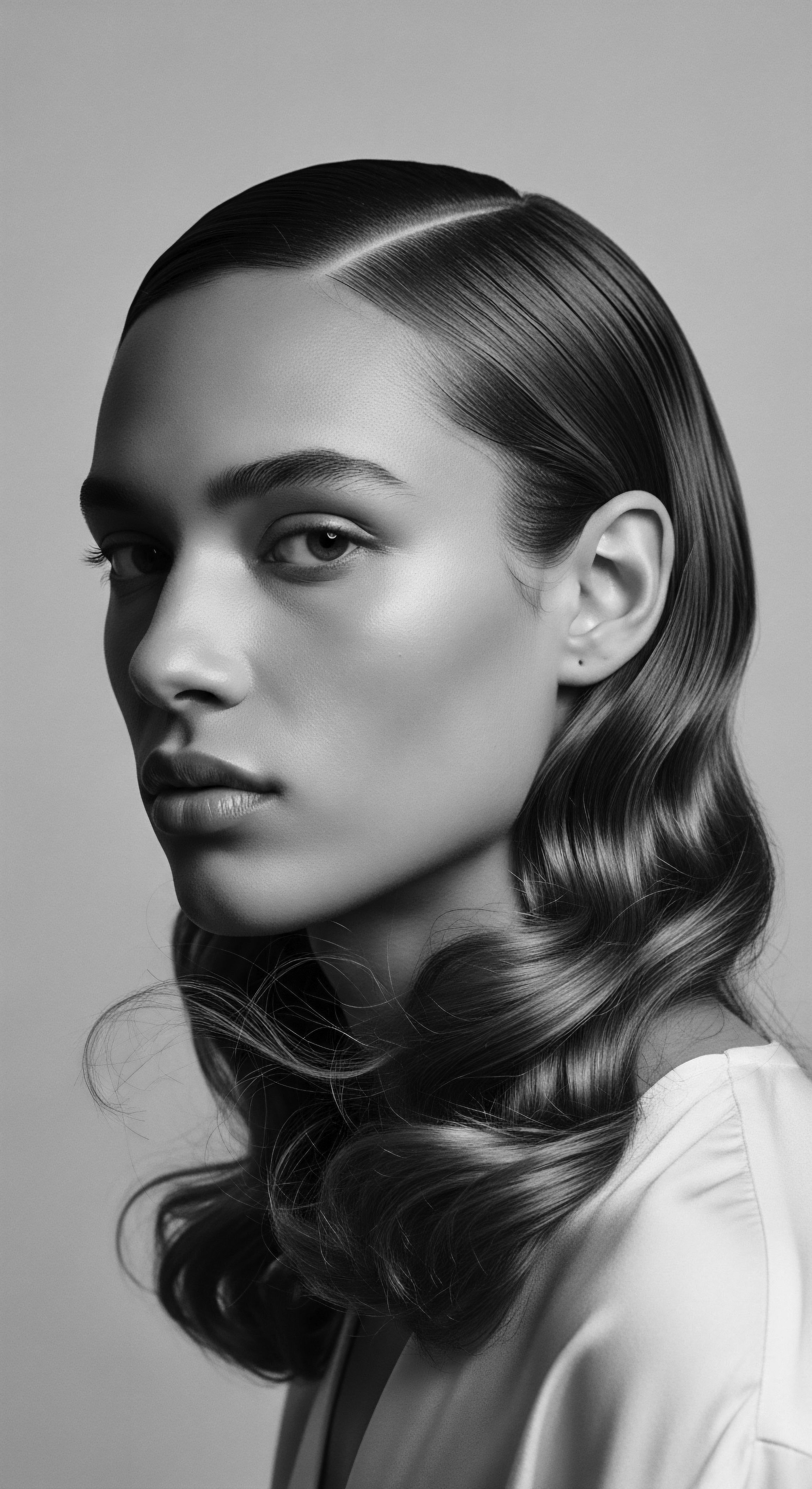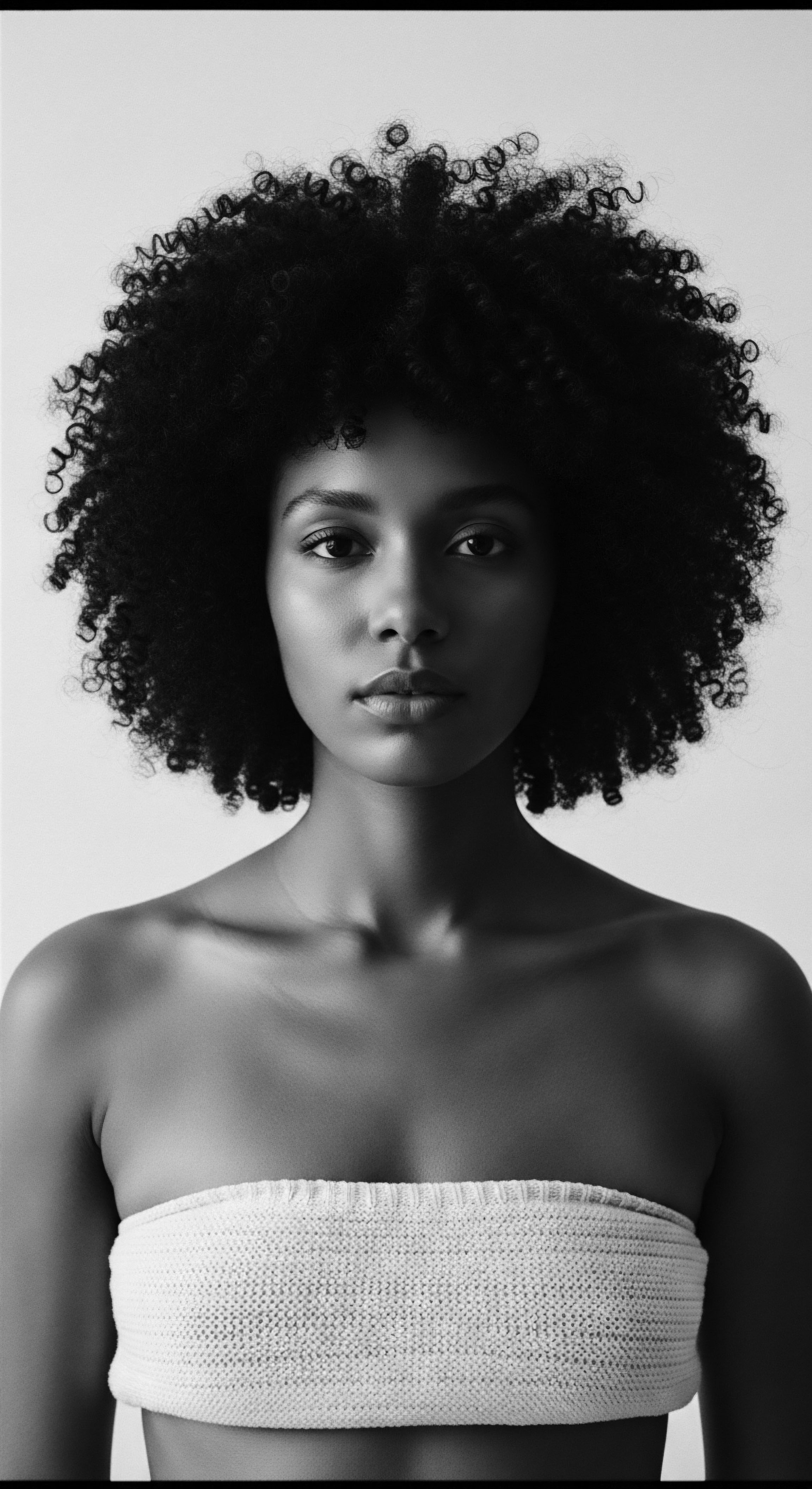
Fundamentals
The very wellspring of our hair’s existence, its organic journey from the scalp, constitutes what we reverently call Natural Growth. This understanding begins with the intricate biological dance of the hair follicle, yet it quickly transcends mere physiology to touch the ancestral pulse within each strand, bearing witness to a heritage centuries deep. Our hair, in its untouched state, carries an indelible blueprint, a genetic legacy that determines its inherent texture, density, and growth patterns.
For textured hair, especially, this means an array of captivating curls, kinks, and coils that define its unique character, a testament to ancient adaptations and a vibrant human diversity. The fundamental explanation of Natural Growth acknowledges this intrinsic vitality, the unceasing rhythm of renewal that commences deep within the dermis.

The Hair Strand’s Blueprint
At the heart of Natural Growth lies the follicle, a tiny, complex organ nestled within the skin. Each follicle acts as a miniature factory, meticulously producing a single strand of hair. The shape of this follicle dictates the curvature of the hair fiber as it emerges. For individuals of African descent, the follicles often possess an elliptical or flattened shape, causing the hair shaft to grow in a curvilinear path, resulting in the characteristic coils and z-patterns observed in many textured hair types.
This structural distinction is paramount to understanding the unique care needs and inherent strengths of these hair textures. The hair shaft itself, composed primarily of keratin protein, undergoes a continuous cycle of growth, rest, and shedding. This cyclical nature is a fundamental aspect of Natural Growth, assuring constant renewal.
The biological designation of Natural Growth refers to hair that has not undergone chemical alterations, such as relaxers, perms, or permanent dyes that break and reform the hair’s disulfide bonds. It also refers to hair that is not consistently manipulated by high heat, which can permanently alter the cuticle and cortex. The meaning of Natural Growth in this elemental sense is simply the hair as it presents itself, straight from the scalp, allowed to follow its inherited pattern. This unadulterated state allows for an authenticity of expression, a direct connection to one’s genetic lineage.
Natural Growth signifies the inherent, unmanipulated journey of hair, a direct expression of ancestral blueprint and biological rhythm.

Early Cultural Meanings ❉ Echoes from the Source
Long before the arrival of colonial impositions, in numerous ancestral African communities, hair was a profound visual language, a living archive of identity, social standing, age, marital status, and spiritual connection. The cultivation of Natural Growth was not a mere aesthetic choice; it was deeply intertwined with daily life, ritual, and communal belonging. Hairstyles, often requiring hours of meticulous braiding, twisting, and adornment, became shared cultural practices, strengthening familial and community bonds. For example, among the Yoruba people of Nigeria, hair held immense spiritual significance, with its care believed to invite good fortune.
Braiding patterns could convey messages to deities, signifying a deep reverence for the unseen world and the interconnectedness of all life. The inherent growth of hair was honored, its unique texture celebrated as a divine endowment.
These ancient practices underscore the foundational significance of Natural Growth, not merely as a biological occurrence but as a sacred component of self and collective identity. The natural oils and butters harvested from the land, such as Shea Butter and Marula Oil, were integral to these care rituals, nourishing the hair in harmony with nature’s rhythm. The intrinsic textured patterns were embraced, forming the basis for elaborate artistry that served societal purposes far beyond simple beauty. This foundational understanding sets the stage for appreciating the deeper meaning that Natural Growth would acquire through centuries of historical shifts.
| Ingredient Shea Butter (Vitellaria paradoxa) |
| Origin/Historical Use West and East Africa; used for centuries to moisturize hair and scalp, protect from sun, and seal moisture. |
| Ingredient Coconut Oil (Cocos nucifera) |
| Origin/Historical Use Widely used across tropical Africa; known for its penetrating properties, nourishing the hair shaft. |
| Ingredient Aloe Vera (Aloe barbadensis miller) |
| Origin/Historical Use North Africa; applied for scalp health, soothing irritation, and conditioning hair. |
| Ingredient Chebe Powder |
| Origin/Historical Use Chad, Central Africa (Bassara/Baggara Arab tribe); renowned for aiding length retention by strengthening hair and sealing the cuticle. |
| Ingredient Marula Oil (Sclerocarya birrea) |
| Origin/Historical Use Southern Africa; a light, easily absorbed oil with healing properties, used to seal in moisture. |
| Ingredient These ingredients represent a profound ancestral knowledge of nature's bounty, passed down through generations to sustain the vitality of Natural Growth. |

Intermediate
Moving beyond the elemental definition, the intermediate understanding of Natural Growth begins to unravel its historical complexities and the profound societal pressures that have sought to redefine, suppress, or even demonize textured hair. For centuries, the inherent growth patterns of Black and mixed-race hair were subject to external judgments, transforming a biological reality into a politicized statement. The concept of Natural Growth, in this historical lens, carries the echoes of suppression and the stirrings of resilience, a silent witness to shifting beauty standards and persistent cultural assertion.

A History of Suppression ❉ The Unnatural Burden
The forced migration of African peoples to the Americas brought a violent rupture of cultural continuity, profoundly impacting the understanding and care of hair. Enslaved Africans were often stripped of their traditional tools, their elaborate hairstyles forcibly shaven, marking an intentional act of dehumanization and cultural erasure. This brutal imposition severed a vital connection to ancestral practices and identity, replacing reverence for Natural Growth with conditions that made its maintenance nearly impossible. Hair, once a sacred identifier, became tangled, neglected, and often hidden beneath wraps, a stark contrast to the meticulous care practiced in their homelands.
Following emancipation, the legacy of these dehumanizing practices persisted. A Eurocentric aesthetic of beauty, valuing straight hair, became dominant, permeating societal norms and even internalizing within Black communities. This societal pressure led many to chemically alter their hair, seeking conformity and perceived acceptance in a world that often deemed natural Black hair as unruly or unprofessional.
The widespread adoption of tools like the hot comb, popularized by innovators like Madam C.J. Walker, provided a means of achieving straightened styles, though these often came with physical and psychological costs.
The historical narrative of Natural Growth is inseparable from the imposed beauty standards that sought to diminish textured hair, yet fueled a quiet, enduring resistance.
This historical context reveals a poignant truth ❉ the meaning of Natural Growth was distorted, becoming associated with backwardness or a lack of polish in a society that valued proximity to whiteness. The concept became a whispered ideal rather than a lived reality for many, yet the inherent resilience of the hair, its biological imperative to grow in its unique form, remained. This period underscores the deep psychological implications of hair-based discrimination, shaping self-perception and contributing to internalised narratives of beauty and worth.

The Whispers of Reclamation ❉ A Return to Source
The mid-20th century, particularly during the Civil Rights and Black Power movements, witnessed a profound shift in the collective consciousness surrounding Black hair. The Natural Hair Movement began to gather momentum, transforming the Afro into a powerful symbol of pride, resistance, and self-acceptance. This period marked a deliberate and collective reclamation of Natural Growth, a conscious rejection of imposed beauty standards and an assertion of inherent Black beauty. The Afro, with its glorious volume and undeniable presence, was more than a hairstyle; it was a political statement, a visual declaration of identity and solidarity.
Individuals began to embrace their coiled and kinky textures, recognizing them as authentic expressions of their heritage. This societal shift, while empowering, also came with new complexities. There were instances of policing within the community, judging individuals on their perceived adherence to “natural” standards.
The journey to embracing Natural Growth was not always linear; it involved navigating societal expectations, family opinions, and personal comfort levels. However, the overarching intention was clear ❉ a desire to reconnect with a fundamental aspect of self that had been historically suppressed.
The return to Natural Growth was, and remains, a powerful act of self-determination. It is a recognition that the hair’s inherent state is beautiful, professional, and worthy of celebration. This period laid the groundwork for the diverse expressions of natural hair we see today, paving the way for styles like braids, locs, and twists to gain widespread acceptance and appreciation. These styles, while ancient in their origins, found renewed cultural significance as expressions of Natural Growth, embodying both personal agency and collective heritage.
- The Afro ❉ A symbol of Black Power and pride in the 1960s and 70s, rejecting Eurocentric beauty norms and asserting Black identity.
- Cornrows ❉ Ancient African braiding techniques that lay flat against the scalp, used historically for identification, communication, and even to conceal escape routes during slavery.
- Locs (Dreadlocks) ❉ A style embraced by Rastafarianism, symbolizing Black identity and later becoming a broader affirmation of Black pride.

Societal Constructs and Self-Perception
The ongoing dialogue around Natural Growth reveals the intricate relationship between external societal constructs and individual self-perception. Research indicates that biases against natural hairstyles can tangibly affect Black women’s opportunities, particularly in professional settings. This pervasive discrimination can lead to significant psychological strain, including internalized racism, negative self-image, and chronic stress as individuals navigate environments where their natural hair is deemed “unprofessional” or “distracting.”, The simple act of allowing one’s hair to grow in its natural state can become an act of profound personal and political courage.
The meaning of Natural Growth for many in the Black and mixed-race diaspora therefore extends beyond biology; it encompasses a journey of healing, a reclamation of self-worth, and a powerful statement against systemic oppression. It is a continuous process of decolonizing beauty standards and affirming an authentic self. The choice to wear natural hair, or to transition to it, is a highly personal decision, often laden with emotional significance.
It is a testament to the enduring human spirit that seeks liberation and self-expression, even in the face of historical and contemporary challenges. This dynamic interplay between the individual’s choice and broader societal norms defines a crucial aspect of the intermediate understanding of Natural Growth.

Academic
At an academic level, the definition and meaning of Natural Growth transcend surface-level observation, delving into complex interdisciplinary considerations rooted in anthropology, psychology, and sociology. It represents not just a biological phenomenon, but a deeply embedded cultural construct, a site of continuous negotiation between individual identity and collective heritage. For textured hair, particularly within Black and mixed-race experiences, Natural Growth becomes a poignant lens through which to examine historical oppression, pathways of resistance, and the intricate dynamics of self-perception and belonging. This exploration necessitates a rigorous examination of the societal forces that have shaped, challenged, and ultimately strengthened the bond between individuals and their hair’s innate form.

The Helix of Identity ❉ Anthropological Significance of Hair
Anthropological inquiry has long recognized hair as a powerful non-verbal communicator, a visual marker of social status, tribal affiliation, spiritual beliefs, and personal expression across diverse cultures. The very structure of hair, whether straight, wavy, or tightly coiled, provides valuable insights into human diversity and adaptation, tracing population histories and evolutionary pathways. For communities of African descent, hair possesses an unparalleled symbolic weight, acting as a living testament to continuity and resilience despite centuries of disruption. The meaning of Natural Growth, in this academic sense, is inextricably linked to the cultural capital accrued over millennia, a repository of ancestral knowledge and a beacon of collective identity.
Consider the Irun Kiko practice of the Yoruba people of Nigeria, noted as early as the 15th century. This intricate hair threading, where hair was meticulously wrapped with thread and then manipulated into various shapes, was not merely a styling technique; it was a protective measure aiding length retention and a profound spiritual practice. Caring for the hair was believed to bring good fortune, highlighting a holistic approach to wellbeing where the physical body was seen as intertwined with spiritual prosperity. This example underscores how, for centuries, Natural Growth was intentionally cultivated and revered through specific, culturally rich practices, its physical manifestation embodying deeper communal and cosmic connections.
The academic scrutiny of Natural Growth also confronts the historical weaponization of hair texture. During the transatlantic slave trade, the deliberate shaving of African captives’ heads represented a calculated act of cultural erasure, severing a vital connection to their homeland and collective identity. This profound trauma laid the groundwork for subsequent centuries where hair texture became a tool of social stratification, with lighter skin and straighter hair often affording perceived advantages within colonial systems.
This historical context, deeply informed by anthropological studies of power dynamics, reveals how the suppression of Natural Growth was a systemic effort to dismantle identity and impose racial hierarchies. The subsequent reclamation of Natural Growth, therefore, embodies a powerful act of decolonization, a rejection of imposed narratives and an affirmation of intrinsic worth.

Ancestral Echoes in Modern Care ❉ The Tender Thread
The contemporary Natural Hair Movement is not a novel phenomenon; it represents a powerful resurgence of ancient wisdom and practices, filtered through the crucible of post-colonial experience. The meaning of Natural Growth in this modern context draws heavily upon ancestral care rituals, demonstrating a continuous thread of knowledge passed down through generations. The renewed interest in ingredients like Shea Butter, Rhassoul Clay, and Ambunu speaks to this ancestral connection. These elements, once staples in African hair care, are now widely recognized for their efficacy in nourishing and maintaining the unique properties of textured hair.
The resilience of African braiding traditions serves as a compelling case study of Natural Growth’s enduring legacy. Even amidst the brutal conditions of slavery, braiding persisted as a quiet yet potent act of resistance and cultural preservation. Enslaved people utilized intricate cornrow patterns not only to protect their hair from harsh labor conditions but also, in some instances, to secretly map escape routes or conceal precious seeds. This profound example powerfully illuminates Natural Growth’s connection to textured hair heritage and ancestral practices.
The hair, in its natural state, transformed into a canvas for coded communication and a silent symbol of defiance against an oppressive system. This is a unique, deeply embedded narrative, often less foregrounded in mainstream discussions of natural hair, yet it provides a powerful illustration of the profound significance of Natural Growth as a tool of survival and cultural continuity. The styles were not merely aesthetic; they were strategic and imbued with profound meaning, representing the ultimate expression of personal autonomy in a dehumanizing environment.
The preservation and adaptation of these practices underscore the profound understanding of Natural Growth that existed within ancestral communities. They intuitively understood how to nurture hair that inherently coils, twists, and shrinks, developing techniques that promoted length retention, moisture, and scalp health long before modern science articulated the mechanisms. The ongoing re-evaluation of these techniques within contemporary hair care signifies a circular journey of knowledge, where modern scientific understanding often validates the empirical wisdom of the past. The definition of Natural Growth thus expands to include the ingenious methods developed across centuries to honor and sustain these unique hair forms.
| Historical/Ancestral Practice African Hair Threading (Irun Kiko) |
| Modern/Scientific Link to Natural Growth Protective styling method that stretches hair and prevents breakage, promoting length retention by minimizing manipulation and tangles. |
| Historical/Ancestral Practice Use of Chebe Powder (Chad) |
| Modern/Scientific Link to Natural Growth A blend of herbs that coats the hair shaft, sealing moisture into the cuticle and strengthening strands, thereby reducing breakage and aiding length retention. |
| Historical/Ancestral Practice Braiding & Coiling Traditions |
| Modern/Scientific Link to Natural Growth Minimize tangles, reduce daily manipulation, and protect ends, which are crucial for length retention and overall hair health for tightly curled textures. |
| Historical/Ancestral Practice Application of Natural Butters/Oils (Shea, Marula) |
| Modern/Scientific Link to Natural Growth Provide emollients that moisturize the hair, reduce friction, and seal the cuticle, preventing moisture loss and improving elasticity. |
| Historical/Ancestral Practice The enduring legacy of ancestral hair care demonstrates a sophisticated empirical understanding of Natural Growth, often affirmed by contemporary scientific principles. |

The Unbound Spirit of Textured Hair ❉ The Tignon Laws
In the crucible of colonial Louisiana, the 18th century brought forth the notorious Tignon Laws, a legislative attempt to shackle the visual exuberance of free women of color whose elaborate hairstyles, often adorned with precious jewels, posed a perceived challenge to the established racial hierarchy (Gould, cited in Miró, 1786). This decree, demanding the covering of their hair with humble tignons—headwraps—aimed to diminish their perceived social standing and enforce a visible marker of their racial subordination, aesthetically linking free Black women to enslaved ones. Yet, from this very constraint, a profound testament to resilience blossomed. Women, with ingenious spirit, transformed the mandated headwraps into statements of defiance, utilizing vibrant fabrics and artful ties that spoke volumes without uttering a single word.
This historical chapter strikingly illustrates how the very concept of Natural Growth, even when obscured, became a silent but potent language of enduring identity and resistance, refusing to be legislated into invisibility. The act of wearing these tignons, initially intended to shame, became a proud declaration of cultural continuity, a quiet rebellion against the imposed uniformity.
This historical imposition, a stark example of hair politicization, reveals how even the aesthetic expression of Natural Growth could be perceived as a threat to a dominant social order. The Tignon Laws were a direct assault on the visual freedom and inherent beauty of textured hair, aiming to control Black women’s bodies and identities. Yet, the creative subversion employed by these women speaks to the indomitable spirit of their Natural Growth—not just the hair itself, but the intrinsic freedom and cultural expression it represents.
Their actions underscored that true beauty and identity stemmed from within, beyond the reach of oppressive legislation. The significance, then, of Natural Growth deepens, encompassing acts of agency and the persistent assertion of self against forces of control.
The Tignon Laws, intended to suppress the visual pride of textured hair, inadvertently became a historical canvas for defiant expressions of Natural Growth and cultural resilience.

The Psychological Terrain of Self-Acceptance
The academic perspective on Natural Growth also delves into its profound psychological implications. For Black women, particularly, the journey to embracing Natural Growth is often intertwined with navigating centuries of negative messaging about their hair. Societal pressures, rooted in Eurocentric beauty standards, have historically led to self-talk that frames natural hair as “ugly” or “unprofessional.” This internalized racism can contribute to significant psychological conflict, anxiety, and hypervigilance about how one’s hair is perceived in academic or professional settings. The choice to wear natural hair, therefore, is not merely a stylistic preference; it is a profound act of self-acceptance and a challenge to deeply ingrained biases.
Research suggests a positive correlation between higher internal locus of control and the choice to wear natural hair, hinting at a connection between personal agency and the decision to embrace one’s inherent texture. (Doss, 2016, p. 23).
The re-emergence of the Natural Hair Movement in the 21st century serves as a testament to the ongoing quest for psychological well-being and authenticity. For many, the process of transitioning to natural hair becomes a transformative journey, fostering a deeper sense of self and a reconnection with ancestral roots. This shift is supported by burgeoning communities, both online and offline, where shared experiences, knowledge, and mutual encouragement foster a sense of belonging and validation. The psychological impact of collective empowerment, challenging stigmatization, offers compelling evidence for the therapeutic potential of embracing Natural Growth.
It demonstrates that our hair, in its natural state, is not just a biological feature; it is a powerful conduit for self-love, cultural affirmation, and mental fortitude. The academic meaning of Natural Growth thus encapsulates a journey of both external and internal liberation, where the personal becomes undeniably political.

Reflection on the Heritage of Natural Growth
As we gaze upon the intricate patterns of a coiled strand, we are not simply observing a biological marvel; we are bearing witness to a profound meditation on heritage itself, a living archive of resilience and unwavering spirit. The Natural Growth of textured hair carries within its very structure the echoes of ancestral wisdom, the tender thread of care passed through generations, and the boundless potential of an unbound helix. Each curl and kink tells a story of survival, of resistance against erasure, and of a steadfast commitment to an authentic self.
The journey of recognizing, honoring, and celebrating Natural Growth is a continuous dance between historical memory and future possibilities, urging us to find harmony between ancient practices and modern understanding. To cherish our hair in its truest form is to honor the enduring legacy of those who came before us, ensuring that this sacred aspect of identity continues to flourish, a testament to beauty, strength, and an unbroken lineage.

References
- Byrd, Ayana, & Tharps, Lori L. (2001). Hair Story ❉ Untangling the Roots of Black Hair in America. St. Martin’s Griffin.
- Doss, Ashley. (2016). African American Personal Presentation ❉ Psychology of Hair and Self-Perception. (Master’s thesis, Stephen F. Austin State University).
- Greensword, Sylviane Ngandu-Kalenga. (2022). Historicizing black hair politics ❉ A framework for contextualizing race politics. Sociology Compass.
- Jacobs-Huey, Lanita. (2006). From the Kitchen to the Salon ❉ Language and Cultural Co-Construction in the African American Women’s Hair Care Community. Lawrence Erlbaum Associates.
- Peacock, Tiffany Nicole. (2019). African American Hair and Beauty ❉ Examining Afrocentricity and Identity Through the Reemergence and Expression of Natural Hair in the 21st Century. (Master’s thesis, University of South Florida).
